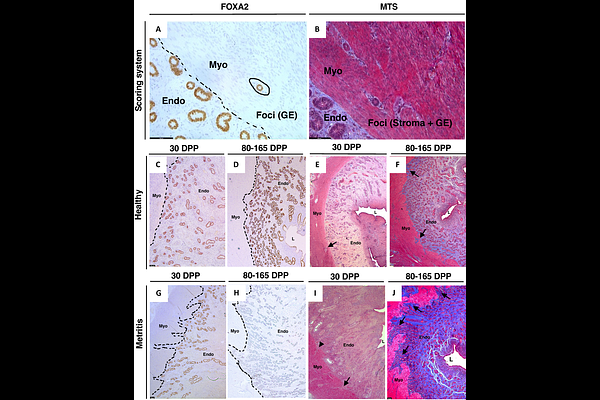Adenomyosis and fibrosis define the morphological memory of the postpartum uterus of dairy cows previously exposed to metritis.

Adenomyosis and fibrosis define the morphological memory of the postpartum uterus of dairy cows previously exposed to metritis.
Sellmer Ramos, I.; Caldeira, M. O.; Poock, S. E.; Moraes, J. G.; Lucy, M. C.; Patterson, A. L.
AbstractOptimal reproductive success following parturition in lactating dairy cows is dependent upon adequate completion of uterine involution. Failure to resolve pathogenic bacterial contamination within the first week postpartum can lead to uterine disease (metritis). Metritis is associated with decreased fertility and a failure or delay to establish pregnancy. We hypothesized that the inflammation resulting from early postpartum metritis would be associated with long-term changes in uterine morphology due to impaired uterine involution within the first 30 days postpartum (dpp). First parity Holstein cows were diagnosed with or without metritis at 7-10 dpp and uterine tissue were analyzed at 30 (Exp. 1), or 80 and 165 (Exp. 2) dpp for the presence of abnormal morphology, including abnormal invasion of endometrial glands and stroma into the myometrium (adenomyosis) using immunohistochemistry for FOXA2 (uterine gland specific marker) and presence of late postpartum endometrial fibrosis using masons trichrome stain (MTS). Severity of adenomyosis was determined by the number and size of adenomyotic foci, distance of foci from the endometrium-myometrium interface (EMI), and degree of fibrosis (MTS stain intensity). The presence, size, and distance from the EMI of adenomyotic foci were greater later postpartum and in cows with early postpartum diagnosis of metritis. Endometrial fibrosis was greater at the stratum basalis (at EMI) compared to the stratum compactum endometrium (near lumen) for all Exp. 2 cows, but greater endometrial fibrosis (regardless of endometrial region) was observed in cows that were diagnosed with metritis. Taken together, these data indicate that early postpartum metritis is associated with long-term modifications to the postpartum uterine morphology, including aberrant endometrial invasion into the myometrium (adenomyosis) and increased pathological fibrogenesis, leading to the presence of late postpartum endometrial fibrosis (scar tissue). Additionally, increased collagen fiber at the EMI suggests a correlation between the development of adenomyosis and fibrosis, which could possibly result from sustained endometrial inflammation caused by uterine disease.